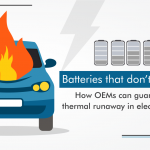Reducing vehicle emissions by reducing weight
Need for fuel efficiency and norms
Fuel efficiency is a continuous goal of the automotive industry. From the 1920s through the 1950s peak efficiencies went from 10 percent to as much as 40 percent, with improvements in fuels, combustion system design, friction reduction, and more precise manufacturing processes. Engines became more powerful, and vehicles became heavier, bigger, and faster. However, by the late 1950s, fuel economy became important, leading to the first large wave of foreign imports. In the wake of the 1973 oil crisis, the issue of energy security arose, and Congress passed the Energy Policy and Conservation Act of 1975 as a means of reducing the country’s dependence on imported oil. The act established the Corporate Average Fuel Economy (CAFE) program, which required car makers to increase the average fuel economy of passenger cars being sold in the United States in 1990 to a standard of 27.5 miles per gallon (mpg) and allowed the U.S. Department of Transportation (DOT) to set relevant standards for light trucks. Today, where there is a scarcity of fossil fuels, increase in pollution, and global warming, we should consider buying cars that are fuel-efficient. By doing so, we can help reduce the damage that is being done to our environment. The lesser the fuel consumption of the car, lesser is the smoke that will come out of its exhaust and better for the environment. Improvements in materials, aerodynamic design, drive train (engine/transmission) efficiency and reduction in overall vehicle weight have the potential to substantially increase the average fuel economy.
Light-weighting solutions
According to a report, Stringent regulations and heavy penalties imposed by government agencies have put immense pressure on automakers to scout different methods and technologies that help curb vehicular emissions. A popular strategy adopted by automakers and different OEMs is to reduce a vehicle’s weight, which significantly reduces fuel consumption and CO2 emissions. A lighter car consumes less fuel because it needs to overcome less inertia, further reducing the power required to propel the vehicle. Losing weight is the easiest way to increase fuel economy; bringing down a car’s weight by just 10% can boost its mileage by almost 6% to 8%.
Vehicle weight distribution
Source: 2014 WARSDAUTO, DuPont Automotive Trends Benchmark Study, conducted by Penton Research
Most of the research has been taking place on use of lightweight materials such as Aluminium, Magnesium, High Strength Steel (HSS), polymer, composites, carbon fibre etc to replace heavier materials and achieve a lightweight vehicle. Majority of research is focused towards developing light weighting solutions in automotive powertrain, chassis, and body components, which constitute up to 80% of total vehicular weight. Shifting their research focus towards these components, OEMs are making significant strides in automotive interior space; covering components such as engines, transmissions, chassis parts, seating structures etc to achieve potential weight savings. It is predicted that High Strength Steel (HSS) and Aluminium will be the most widely used materials in automotive manufacturing by 2030.
Light-weighting of transmission by Downsizing
The best way to make sure the horsepower produced by an engine makes it efficiently to the rear wheels is to reduce the rotating weight of the driveline to the absolute limit without sacrificing durability. And generally, because of gear reduction at the transmission and rear differential, the closer to the engine you get the greater effect it will have on the car. That’s why a properly designed and a compact transmission can be a tremendous advantage.
With necessary and increasing demands to reduce emissions and improve fuel economy, automotive transmissions have evolved over the past 20 years while rapidly progressing toward electrification. Likewise, the trend towards electric cars needs lightweight design to compensate the additional weight of battery systems. Thus, the need for weight reduction is also present for transmissions. Besides the design of the transmission itself, the production technology has a significant impact on the weight saving potential of individual components.
Forging technology can offer both weights saving potential as well as cost efficiency. Due to the high strength, formed components can be designed more robust and with thinner walls leading to a reduction of the weight and size of the components.
Net shape or near net shape forging eliminates machining, laser welding etc. This state-of-the-art forging process leads to an uninterrupted fibre flow which precisely follows the outer shape of the gears as well as strain hardening, enhancing mechanical properties like fatigue limit and strength. By these beneficial mechanical properties, it is possible to design and produce smaller components leading to significant weight reduction and raw material savings.
Thus, the Benefits of Reducing Weight are:
Reduce cost: This is achieved by reducing the amount of raw material used in the manufacture of the transmission. Further cost savings can be achieved through a reduction in processing, handling, storage and transportation costs.
Reduce fuel consumption: By reducing the weight of the transmission, fuel efficiency is improved.
Reducing emissions: By reducing the weight of the transmission, it reduces the load on the engine thereby reducing unburnt hydrocarbon emissions.
Solutions by O-OKA
In order to help automakers, attain weight reductions in transmissions, O-OKA Japan, is using the process of net-shape forging to produce a wide range of gears, aiming to minimize material usage and machining efforts to further downsize, imparting optimum material strength. O-OKA makes 42 million net-forged gears per annum for its OEM customers worldwide which find a variety of applications in transmissions such as manual, semi-automatic, automatic, hybrid, DCT, and EV powertrains.
Please do share your comments and insights below.
For any feedback or questions, you are most welcome to contact me at prashant@quanzen.com





